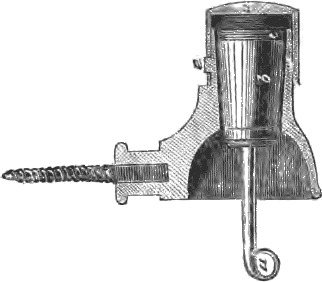[Trade Journal]
Publication: The Mechanics Magazine
London, England
vol. 66, p. 277
Mr. John Woodman, of Manchester, has also introduced an improved telegraph wire insulator. Instead of cementing the stalk of the hook through which the wire passes into a thimble, and cementing the said thimble into a cylindrical chamber of a cast-iron bell, he makes the bell open at the back, with a cap or cover to fit closely on it. He fastens the stalk of the hook or eye into a conical shaped non-conductor, which he passes through the bell at the back. By its conical shape, the smallest part being foremost, it forms a wedge, whereby the more stress or strain comes upon it the tighter it fits, and thus becomes waterproof; and as an additional tightener, an elastic ring is put around the thich end of the non-conductor, which causes it to fit perfectly close, and the cap or cover being then put on, and secured by a peg or pin, preserves it from the weather or accident. It is evident, that by this plan, whenever the hook or eye becomes broken or out of order, it may be taken out and repaired, or replaced with a new one, without disturbing the whole of the insulator, by merely taking off the cap or cover, and taking out the non-conductor and hook or eye.
Fig. 3 of the engravings is a view of the insulator complete. a represents the hook or eye; b, the conical shaped non-conductor; c. the elastic ring, and d the cap or cover which slides on the outside of the bell, and is secured by the pin or projection e.
 |
| Fig. 3 |
